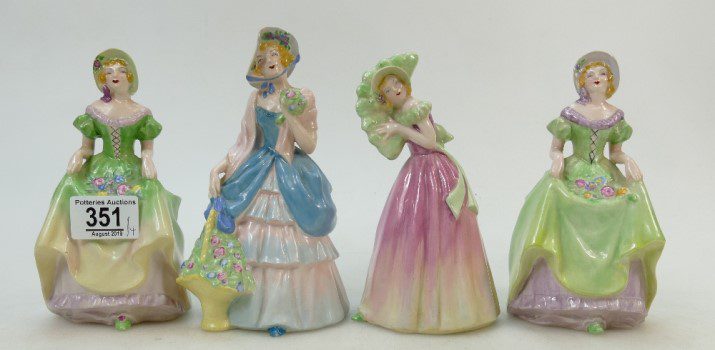
This delightful collection of Crown Devon figurines is a wonderful example of why the pottery brand is so popular
Did you know that Crown Devon pottery, and the Fielding family, were instrumental in the development of the lustre-ware pottery we know today? The family’s passion for creativity and innovation helped the whole of the pottery industry in Stoke-on-Trent.
Crown Devon was also very famous for the vellum blush ware range, which is hugely popular in the USA today. The rich history of this manufacturer has added to its collectability.
We’ve dug a little deeper into the history of this fascinating pottery company to help you understand the differences in the markings.
The History of Crown Devon Pottery
Crown Devon pottery started its life as S. Fielding & Co, which is why you’ll find a variety of backstamps and markings spanning the years. Simon Fielding took over the Railway Works in Stoke-on-Trent in 1878 and started making pottery. Early pottery such as the Fielding ‘majolica’ really put S. Fielding & Co. on the map.
From 1921, the Crown Devon name was introduced, and the Railway Works was renamed the Devon Pottery.
One of the most distinctive things about Crown Devon pottery is how it was able to ‘undercut’ its competitors at the time – creating lots of rivalry, but also competition, as there was now a British manufacturer that could compete with imported products.
As Art Deco became more popular, Crown Devon responded and created new ranges and finishes to meet demand, the ‘mattajade’ range being one of the most popular and recognisable. But it was really the work that Crown Devon did to establish the lustreware we now know today that we should be thankful for.
Whilst the Crown Devon factory closed its doors in 1982, the wonderful figurines, products and tableware sets are still very much sought after and collected today. Crown Devon pieces do well at our auctions, bringing colour and that tell-tale Art Deco style into the auction room.
You can find even more out about the history of Crown Devon in our detailed blog post here.

A lovely little sale price of £80 for this bright Crown Devon Art Deco vase in one of our recent auctions. Decorated with a geometrical Art Deco design on orange ground, it stands at 26cm.
What Crown Devon Pottery Marks and Backstamps Should I Look Out For?
Before 1912, and the renaming of Crown Devon Pottery, you might find older pieces of earthenware made at the Railway Pottery. These pieces could be impressed with the name ‘Fielding’ and marked with dates from 1880 to1913. Other early marks to look out for include ‘S F & CO’ or ‘SF & CO England’. Occasionally, the registration number and the pattern were also included in the mark.
From 1912 onwards, the Crown Devon name was used, and the more familiar crown symbol was incorporated.
We’ve listed some of the most well-used markings to help you to start to identify your pottery dates. It’s important to seek professional support to help identify ‘fakes’ or ‘copycat’ pieces. Here at Potteries Auctions, we are experts in spotting the difference.

This was one of the first markings to start to incorporate the Devon name. This was used from c.1913 onwards.

This marking can be found on your pieces dated from c.1913-30. Generally speaking, from 1917 onwards the initials ‘SF & Co’ were often not used on the markings.

The Silverine marking was a trade name for pieces with a high shine glaze. It was often used on tea and coffee sets.

You will find the following stamp most commonly used on bowls and vases. The Lusterine name was a Fielding’s ‘brand name’ for pieces with a lustre finish. It was used from c.1917-30.

Many of the Devon ware pattern pieces had their own backstamp and marking. Here, you can see an example from the ‘MAVIS’ range. This stamp was used from c.1917-30.

From the c.1930s onwards you’ll most commonly see this stamp used. In the 1960s trade reference book, it was noted that this style of mark was used for Crown Devon.
Do you recognise any of these markings on your pieces? If you need further support, Potteries Auctions can step in. We can help you identify the date and rarity of your pieces.

This is Crown Devon Fieldings Musical Cigarette Dispenser of a dog outside a kennel, recently sold at auction for a wonderful £140!
Is Crown Devon Pottery Valuable?
As with all pottery and ceramics, there is a huge variation in the value of a piece based on its age and condition. It’s why it’s often best to get valuations and expert advice.
At Potteries Auctions, we can identify and provide valuations on a wide range of Crown Devon pieces. Our team can help value your collection, turn you into a collector, or advise on how much your Crown Devon pottery could be worth.
Please get in touch with us to discuss how we can help you or request a call back if you are looking for an expert evaluation and are seeking to sell your Crown Devon pottery. Alternatively, you can join us at one of our valuation days, email us for an appointment on enquiries@potteriesauctions.com or call us on +44 (0)1782 638100 Monday to Friday, 9am to 4pm.
